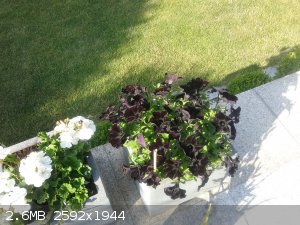MeshPL
Hazard to Others
  
Posts: 329
Registered: 20-4-2015
Location: Universe
Member Is Offline
Mood: No Mood
|
|
Extraction of pH indicator from black pellargonium
My mum being a big fan of monochromatic flowers has some black pellargoniums. I collected some of the dry petals that fell off and were sitting on the
ground but were not mouldy or decomposed yet. Roughly 10 flowers were used.
Washed them a bit with water and poured some demineralied water to those petals in a jar. The water quickly became dark, with purplish tinge. I heated
it up in a microwave and than replaced the water which I also heated in a microwave, smashee the petals a bit with a spoon and left to stand
overnight. In total I got 250 ml of dark liquid with purple-blue tint. The petals which were left were green-chlorophyll is not watersoluble and could
not be leached. I took the liquid and boiled it. It became dark green (color best described as dry grass), but the residues left on the sides of the
beaker were still blue indicating a pH change due to the expulsion of dissolved CO2 or some contamination rather than actual decomposition of the
anthocyanines. Not much of the water was evaporated, as I did not have time to boil it too much.
I tested the color changing proprieties. Addition of HCl or acetic acid made it bright pink-red, KH2PO4 resulted in pale orange-red solution, sodium
bicarbonate made the extract more green. Strong bases like NH3 and KOH turned the extract yellow with orange tint.
I guess that merely crushing the flowers and adding them to some boiling water and letting it stand for a while would be sufficient to extract most of
anthocyanines. Even few flowers are enough to color quite a bit of water. I recommend using black pellargoniums or potentially any other "black"
flowers to anyone looking for easily extractable natural ph indicator.
|
|
|
Magpie
lab constructor
    
Posts: 5939
Registered: 1-11-2003
Location: USA
Member Is Offline
Mood: Chemistry: the subtle science.
|
|
If you need another challenge go after the pelargonic acid.
The single most important condition for a successful synthesis is good mixing - Nicodem
|
|
|
AvBaeyer
National Hazard
   
Posts: 651
Registered: 25-2-2014
Location: CA
Member Is Offline
Mood: No Mood
|
|
Mesh,
Nice post. I love this kind of thing!
AvB
|
|
|
MeshPL
Hazard to Others
  
Posts: 329
Registered: 20-4-2015
Location: Universe
Member Is Offline
Mood: No Mood
|
|
Did it again with 2 fresh flowers and about 50 ml of water. Microwaving was necessary to extract the dyes into water, which were blue. Upon prolonged
heating the extract turned green. After cooling and letting it stay open in the jar the extract once again became brownish green.
The nature of this blue->brown transformation is not known. Long heating and perhaps boiling is certainly necessary to effect it. But heating
cannot be all thet is required as residue left on glass container walls used for boiling is also blue, not brown. Maybe I will eventually test the
proprieties of both boiled and not boiled extracts. My material for tests is limited however (we got only one black bush which currently serves a
decorative purpose.
In any case, black pellargoniums are suitable material to produce pH sensitive extracts, the nature of which is not yet fully assesed.
|
|
|
Amos
International Hazard
    
Posts: 1406
Registered: 25-3-2014
Location: Yes
Member Is Offline
Mood: No
|
|
This sounds like anthocyanins might be a major contributor to the color. If you extract the petals with methanol, especially in a Soxhlet extractor,
you can get a more concentrated solution of the dye. What is very key to preventing the decomposition of the anthocyanins is to use an acidic
environment. Methanol with a few drops of hydrochloric acid added gives the most deeply colored extract in my experience, and for long term storage it
is also best to keep pH very low. Hope this might help for future runs!
[Edited on 6-13-2017 by Amos]
|
|
|
Magpie
lab constructor
    
Posts: 5939
Registered: 1-11-2003
Location: USA
Member Is Offline
Mood: Chemistry: the subtle science.
|
|
Is your plant a rose geranium, Pelargonium roseum, by any chance? I notice that the spelling is slightly different so I may have the wrong
specie.
https://books.google.com/books?id=Ay3mAAAAMAAJ&pg=PA194&...
The single most important condition for a successful synthesis is good mixing - Nicodem
|
|
|
MeshPL
Hazard to Others
  
Posts: 329
Registered: 20-4-2015
Location: Universe
Member Is Offline
Mood: No Mood
|
|
I don't know. We just call it pelargonium, and I commited some misspellings by writing pellargonium.
I don't know the exact species, but here's the photo.

|
|
|
UC235
National Hazard
   
Posts: 565
Registered: 28-12-2014
Member Is Offline
Mood: No Mood
|
|
Quote: Originally posted by MeshPL  | I don't know. We just call it pelargonium, and I commited some misspellings by writing pellargonium.
I don't know the exact species, but here's the photo. |
The plants in the container to the left are "geraniums" in common lingo, genus *Pelargonium*. The plant you are using is a petunia.
|
|
|
MeshPL
Hazard to Others
  
Posts: 329
Registered: 20-4-2015
Location: Universe
Member Is Offline
Mood: No Mood
|
|
%&○₩♧>☆#!
My bad, they were Petunias! I'm not a botanical expert. My bad. Sorry.
BTW, my extracts just went stale. Despite low sugar content of flower extracts compared to cabbage or other vegetable extracts, the indicator becomes
foul just as fast as one would expect from any plant extract. One would need to pasteurise the extracts properly to store them, microwaving them is
not enough.
|
|
|